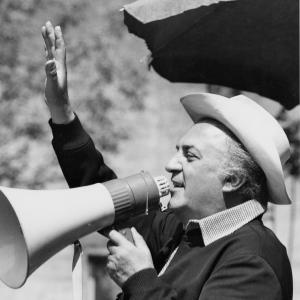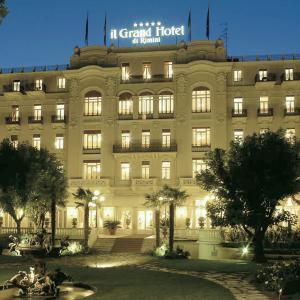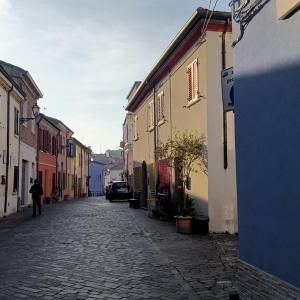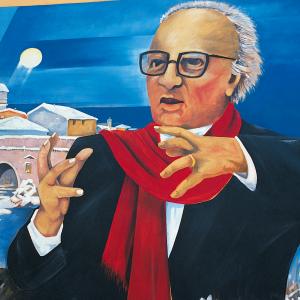In Fellini’s footsteps: A journey through the Maestro’s Rimini
Rimini is Federico Fellini’s city, a place made famous around the world thanks to his films… even though he never filmed a single scene there. Yet the city of Rimini has remained indelibly fixed in the memory of cinema, thanks to a number of iconic places such as the port, the beach, the Grand Hotel, the Piazza Cavour, or even the Fulgor cinema.
This itinerary is a way of discovering Rimini through the life and eyes of the person who made it famous.
It is worth starting out from the Via Dardanelli, on the other side of the railway track, on the sea side, to discover the very place where Fellini was born, the house at no. 10, even though his parents soon moved to the historic centre of the city.
The road that leads to the beach, which Federico crossed many thousands of times, travels from the Viale Principe Amedeo right to the Piazzale Federico Fellini, which is dominated by the Fontana dei Quattro Cavalli, the Fountain of the Four Horses, reconstructed in its original form and position in 1983, by relocating the horses which dated from the 1928 monument, and reconstructing the large basin that was demolished in 1954.
After you pass the fountain, you’ll see the majestic Grand Hotel on your left, with its garden park that extend quite a way along the route to the sea.
This magical hotel, a symbol of the Belle Epoque, remains just as fascinating today. For Federico, it represented a central element of his imagination, almost a starting point for his fantastical youthful dreams, in which he imagined voluptuous, refined ladies dancing in its large, sumptuous rooms, and later a point of arrival and ‘comfortable retreat’, when, by now a well-known director, he always sojourned in his favourite room, no. 315. The hotel’s interiors are also a must-see, as its spaces are a feast of enchantment and imaginative visions, tempting you to savour the atmospheres of times gone by, in which luxury and seduction dominated. So, go and visit the terrace and take the staircase that leads down to the park for walking on towards the seaside.
Before you reach the beach, on the right you’ll find the Fellinia, the outsized Ferrania photographic camera that has been a local feature since the 1940s. From here, once you arrive at the beach, look out to sea to be reminded of the reconstructed waves on which sailed the Rex, the transatlantic liner that everyone flocked to see, which Fellini recorded in Amarcord, even if it was only in his imagination.
Along the Viale Regina Elena, from the Canal port to the Piazza Marvelli, you will easily noticed the streets that bear the names of Fellini films, a total of 26 streets in the heart of Rimini’s Marina dedicated to the same number of films and screenplays of his most famous films. In essence, they provide a singular and significant way to physically label the city with a complete filmography of the famous director.
After a brief stop on the Piazzale Fellini, we recommend proceeding towards the Porto Canale, the winter destination for the layabout “Vitelloni”. Strolling on the Porto Canale is an emotion in any season, and you will never be disappointed. Bringing Federico’s words to mind will fill you with emotion. “Last night, I dreamt of the port of Rimini opening up over a swollen sea that was green and threatening, like a moving field above which dark clouds raced, towards the ground”. This is the Amarcord pier, the thinned out shapes of the fishing boats, the ghostly veils, the vague glimmer of the water.
Our itinerary continues towards the Piazzale Marvelli (formerly the Piazza Tripoli) overlooked by the Chiesa dei Salesiani, the Salesian Church that Fellini watched built and that he attended for an entire summer, when his parents sent him to boarding school there.
In summer, there is a continuous chatter, with the coming and going of tourists. Here, we can imagine a young Federico fenced in by the walls that surrounded the church’s basketball court, intent on greeting “the shouts of the people going for a walk with an ice cream in their hands”.
It is a short journey from the Marina to the railway station, a metaphor for any departure, which had particular meaning for the Maestro. Fellini and his friends loved to watch the trains arriving and departing, so much so that he wrote: “Once, we saw an train all in blue. It was the sleeper car. A curtain rose, and a gentleman in pyjamas appeared”.
From here, you can reach the Via Roma in the blink of an eye, where at no. 41 you will find the home of Titta, his Gymnasium and High School friend, who would later become the well-known lawyer Benzi, and remained Federico’s friend his entire life. A beautiful villa, surrounded by a garden, where Titta lived with his family. A house that Federico knew so well that it provided the inspiration for that of the protagonist in the film Amarcord, with the creaking gate and the steps leading to the front door. The same house that Titta’s grandfather in the film could not find because of the fog, leading him to reflect, dismayed, that he no longer seems to be anywhere at all. Exteriors and interiors in which, albeit only in the film, the story of a typical family from the Romagna of yesteryear is told.
From the Via Roma, the stroll continues towards the Tiberius Bridge, and more importantly, towards the Borgo di San Giuliano, one of the city’s most Fellini-like sights. It is no coincidence that the murals to be found on the façades of the houses that conjure up Fellini and his world were created here. The area is a concentration of quarters, small squares and dead ends in which the atmosphere that you breathe is from another era. It is the same that you will find at the start of the film The Clowns, which is set in Rimini. Here, the old taverns have been transformed into well-known restaurants and the repainted houses have lost their old, crumbling walls. But murals have also appeared on these homes, which all contribute to creating an atmosphere that is both magical and evocative.
From the Borgo, head towards the Corso d’Augusto to reach the road on which the cars of the Mille Miglia once roared by, and immediately after that, as you head towards the city centre, you stumble onto the Cinema Fulgor, which after five years of restoration and renovation, has been returned to Rimini and its inhabitants. A Fellini site par excellence, which once again embodies the aegis of the poetic and evocative Rimini that Fellini loved so much and that you will find in his films. It was at the Fulgor that the Maestro opened his eyes to the world and first encountered American cinema.
The Fontana della Pigna is in the Piazza Cavour, clearly visible in the scenes of Amarcord where it forms a snow-strewn background for Gradisca, enchanted by the arrival of the peacock. There also was the Bar Commercio, and the Galli Theatre, the foyer of which formed the funeral chamber on November 4, 1993 where his friend, Sergio Zavoli, delivered the funeral oration.
From the Piazza Cavour you can proceed towards the Castel Sismondo, which Fellini described as “the Rocca, Francesca’s prison, at the time full of petty thieves and drunkards”. It was in the square in front that he would go to see the Circus and observe his beloved circus artists during the day.
Today, this square, the Piazza Malatesta, is also called the Piazza dei Sogni, the Square of Dreams, in Fellini’s honour. This urban layout has been designed with three main areas: the Velo d’acqua (the Veil of Water) and the Circo della vita (Circus of Life), to which are added the part inspired by the scenery in Amarcord and the illuminations by Tonino Guerra.
The area adjacent to the Galli Theatre has been transformed into the Circo della vita, an 8½-meter wide ring with a large circular bench at its centre symbolising a hymn to life and the desire to be together.
From the Rocca, it is a good idea to turn back and return to the other end of the Piazza Cavour to take the Via Gambalunga to see the Palazzo Ceschina at the end, where young Federico lived from April 1926 onward, right in front of the Ferrari School. Returning along the same street towards the centre, you will need to take a look at no. 27, the Palazzo Gambalunga, which housed his Gymnasium and which is now home to the city’s large, prestigious and elegant Library.
Perpendicular to the Via Gambalunga, you will find the Via Angherà, where Fellini’s nursery can be found at no. 21.
From Via Gambalunga, heading towards the centre, you will come out onto the Piazza Ferrari where, in the part of the public gardens that has remained as it was, (another part has given way to the Museo della Domus Romana, also known as the Surgeon’s House) the ‘statue of the nudes’ will catch your eye: the Monument to Victory or rather, to the Fallen of the First World War, erected in the early 1920s and inaugurated by King Vittorio Emanuele III, which made Fellini dream so much. “This is the monument to Victory… we went to see it every day... And I even dreamed about it at night!”, recounts the voice-over by Titta, Fellini’s “doppelganger” in Amarcord.
From here, you can take the Via Tempio Malatestiano to go sraight to the Tempio Malatestiano, Rimini’s cathedral, which Fellini and his friends frequented “particularly because that’s where the girls were”, as his friend Benzi recalls.
The next stop is the Piazza Giulio Cesare, now known as the Piazza Tre Martiri because, as the Maestro recorded, “the Nazis hanged three people from Rimini there”. Today, the Bar ‘da Rossini’ where Federico’s group went to play boccette is now the Bar Turismo.
Returning for a moment towards the Piazza Cavour along the Corso d’Augusto, you pass in front of the Palazzo Ripa, once no. 63 and now no. 115, one of the houses in which Fellini lived with his family, “the first that I really remember”, as he wrote.
Continuing with today’s Tre Martiri square behind us, we reach no. 62, the seventeenth-century Palazzo Buonadrata (even if the façade was rebuilt after the earthquake of 1786), now home to the Fondazione Cassa di Risparmio di Rimini, with its frescoed rooms and halls in which Fellini attended high school.
In February 1929, the family moved to no. 9, Via Clementini. This was where Federico entered adolescence, while the house on the Via Dante, apparently also no. 9, was a later family home, where they moved in April 1931.
Leaving this street, you continue to reach the Via Oberdan, where we find the house in which Federico lived until his mother’s death and which from 2001 to 2009 was the headquarters of both the Fellini Foundation and Museum.
Now, the new widely-spread Museum is housed in three spaces: The Castel Sismondo, Palazzo del Fulgor and Piazza Malatesta.
Extract from the publication “Amarcord a Rimini con Federico Fellini” (Amarcord in Rimini with Federico Fellini).



